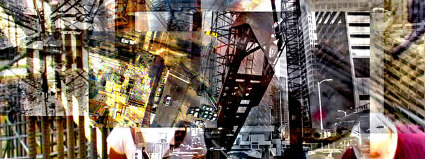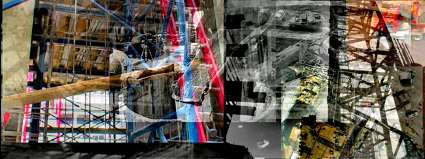LS: The idea was born out of a need to have a continuous and changing flow of information. This would then be churned by the software to create generative combinations of work. Secondly, my work was long involved with existential ideas of "being" and awareness of oneself in the larger spectrum of the world in which we live (62 Days was an attempt to do that).
MK: Your new media work blends memory and history. I’m interested in the way you say “video-memory” which separates it from human memory. Yet in many of your installations, the blend of what’s happening now, with layers of deep memory, more distant, the layers of time, is like both an individual’s memory and in the public works, as much history as memory, where current events take place not in an isolated present tense, but with consciousness of fragments of the past. Your works, which present changing collages invite both emotional involvement, and analysis.
LS: The term video memory was an attempt to define something which is separate from computer or human memory. I felt that video memory might best refer to what was resulting from the process.
The work is adaptive and contextualizes to its environment. It presents a constellation of memories from which we derive "meaning" or "narrative.” I often find myself lost in the screen-scape of the work, watching the images wash over each other and present new potential realities.
MK: The still screen shots in Merge, are a kind of Grecian Urn of movement halted. These were created at specific intervals of time. What about the other prints? How do you create them?
LS: The prints are created by the software. Again, it is a continuation of the idea which calls for the work to generate itself. I simply supply the initial seed.
MK: A number of your works, proposals for these works, call for cameras and screens in a number of locations (10 stations in public transit stations, Culture Merge, with video “captured” in Tokyo, Bombay, Buenos Aires, Los Angeles—and images are layered and sent out from a central server. Do works like these have a social agenda/philosophical view of humankind?
LS: The agenda is to explore global similarity and difference.
MK: When you talk about a work beginning, you use the word “born.” Would you tell us why?
LS: I think of it as the beginning of its consciousness, a birth.
MK: You’ve given a number of years of “life” to some of these works. What happens at the end of that time?
LS: At the end of that time, the piece will stop accruing new memories. It will continue to explore its existing memories.
MK: Your 2006 work Next, you say, “deals with the way we attempt to assemble a narrative of our lives…. Onscreen, sections of images are fit together like a puzzle-- some bleeding through, others demonstratively opaque. Images are seen appearing and disappearing at a brisk rate. They recombine to create new hybrid compositions, which feel decidedly optimistic as the puzzle comes closer to being solved.” But who or what solves it? It has to be the viewer?
LS: Yes, it is the viewer. My work proposes possibilities and impossibilities. I am not concerned with the individual moments in time, but how they conjoin.
MK: And, there’s a sort of paradox, because to stop to look, to watch Next is to stop all other action, and the present then becomes contemplative or searching. So it’s like Heisenberg uncertainty principle, in which the watching/measuring of something changes it?
LS: Exactly. There is no way to achieve both, they are interdependent.
MK: You say you have this work in your home; that one makes “very real decisions about what you will and what you won’t share with this piece: you never know what will come on screen and be re-presented again unpredictable and engaging.” So how do you “not share”? Avoid the space? Stay out of visual range?
LS: That is all you can do. You sneak around the camera (it runs 24hours per day). You learn a lot about yourself.
MK: Does this self-consciousness make you more aware of life, the passage of time?
LS: It is fantastic. It provides new primary memories of my life. Just like the photo we have of ourselves at the age of 4 which become the primary memory of our self at that age. This work creates new primary memories.
MK: You say it’s like having another person, another “entity” in the house. Do you get used to it?
LS: I did, my wife has not.
MK: Some of your computer works are generative, others interactive and generative. Do you do the programming yourself, modifying existing programs?
LS: All the programming is done in my studio.
MK: As you create these art works with computers—what do you do about backing up the images in case of a system crash? [Sorry to mention this.]
LS: Great question. Every night the software backs up the video files to an external firewire drive. The collector can seamlessly unplug the drive at any point and back it up. It is a straight forward data backup process. When you buy my work, you are given 2 copies of the software. So, if the computer crashes, you have the software and the video memories.
MK: As you’ve mentioned, the great number of combinations of images makes it unlikely that exact combinations repeat; therefore, because someone is not looking at the screen at all times, many of the combinations of images are never viewed. They can’t be. Is that impossibility of seeing it all, philosophically, a part of the art work as you conceive it?
LS: It is like life, we will never be able to digest all the stimuli and ideas which we daily experience.
MK: When these works are in public places, images are captured and they become a part of the data. Notions of privacy, what we can expect, have changed so that it’s not seen as a violation. Assuming available technology, do you think that works like, say, Stations, would have been acceptable before CCTV cameras became widespread?
LS: I like to think of my work as the benevolent big brother. The ubiquity of CCTV cameras has certainly changed our perception of privacy.
MK: How would you characterize the development of your video works from the early works to those in which you are currently engaged?
LS: They are better and merging the layers of time.
MK: Each time your work has changed, it’s been, as you’ve described it, because you were consciously aware of either something you wanted to leave behind, or something you wanted to move towards. How do you see your current involvement with video? You’re successful, getting great commissions and creating exciting work. Now what? Can you anticipate another leap—or do you think you’ll continue these explorations for a while longer?
LS: I have a book full of ideas that I want to explore, they all involve video, memory and time. I think that it is very fertile territory, worthy of much more exploration. Stay tuned for more!
MK: We will stay tuned—and will be happy to hear more from you. Thank you for the time you’ve taken in answering these questions.

Commission for McCormick Place
West Expansion
in progress / generative video work

600 North Fairbanks Project
2007 / archival
prints. 11.25" x 30"

600 North Fairbanks Project
2007 / archival prints. 11.25" x 30"
Per Contra is dedicated to the arts. Please, remember that each work takes time, talent, commitment and money. Please do not copy without permission. Thanks!
